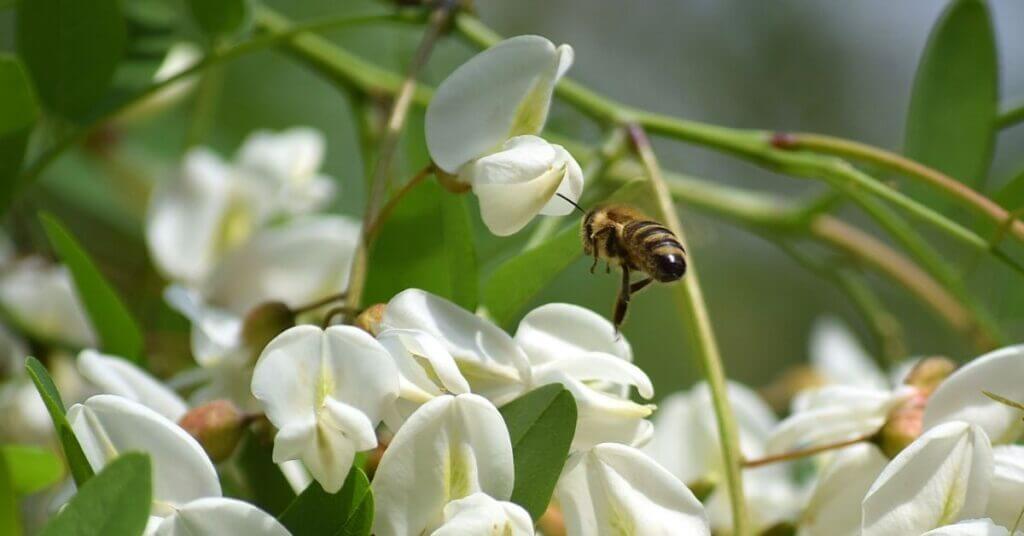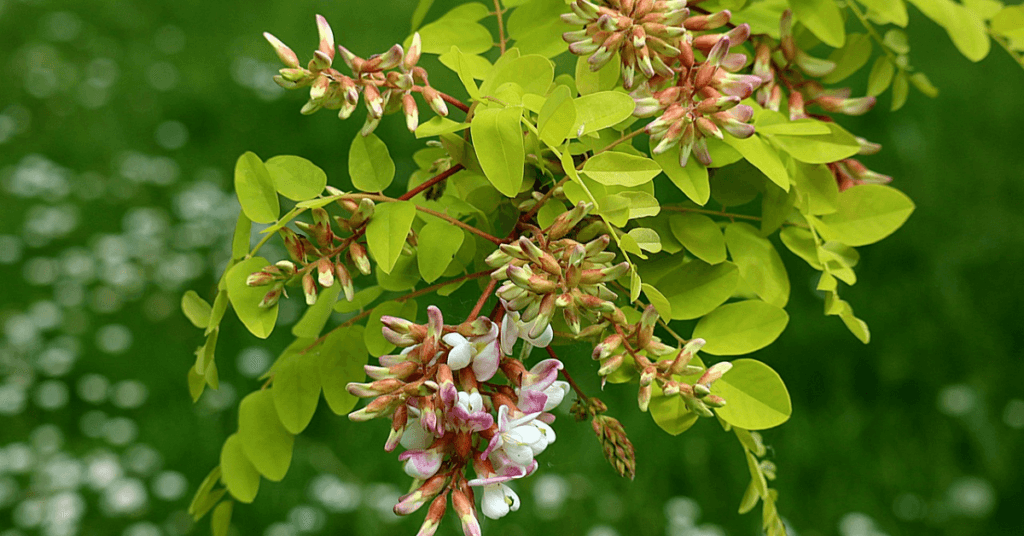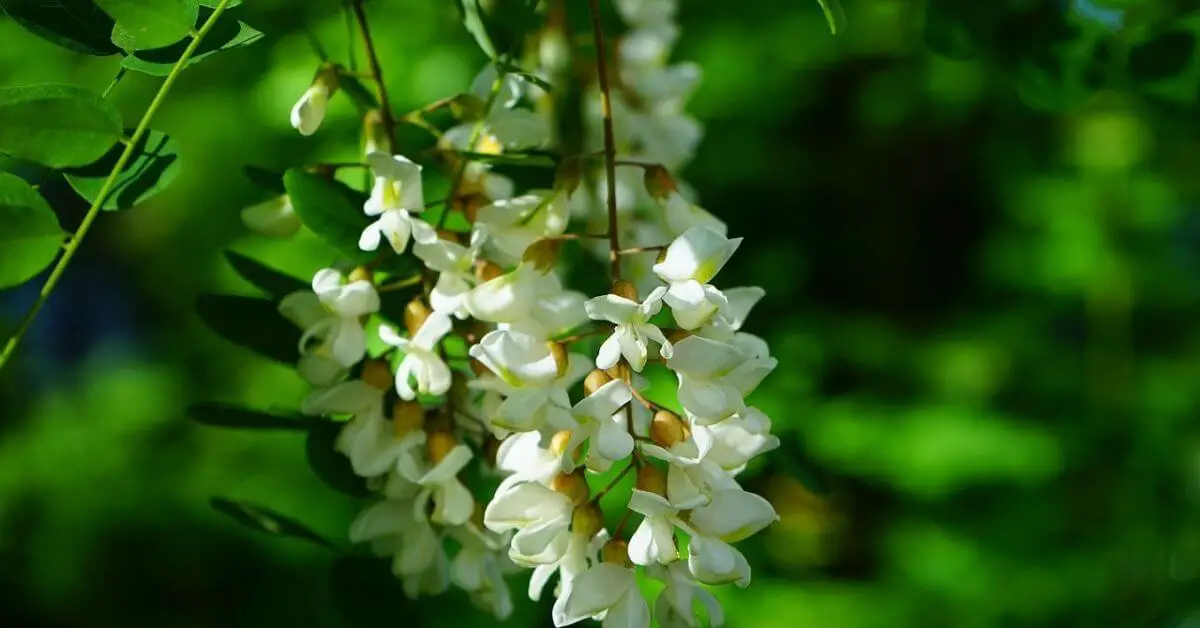Introduction
The black locust (Robinia pseudoacacia) is a tree family of legumes (Fabaceae). It is also known as false acacia and Robinia. It is native to Central-eastern United States ( spread across many regions worldwide.).
Locust is a deciduous tree. Deciduous trees are huge flowering plants. Such as oaks, maples, and beeches. Tree height is about 65–100 ft. It has fragrant white tufted flowers.
Black Locust wood has great hardness and durability. Therefore it is a great option for extreme weather and external application. Black Locust is a versatile wood species. It is used for many purposes, such as furniture, firewood, and marine. It also performs very well in moisture. So many boat manufacturers use it without any problems.
| # | Black Locust |
| Scientific Name: | Robinia pseudoacacia |
| Wood color | Pale greenish-yellow to a darker brown |
| Tree height : | 40–100 feet (12–30 m) |
| Trunk Diameter: | 2–4 feet (0.61–1.22 m) |
| Janka Hardness: | 1,700 LBF (7,560 N) |
| Average Dried Weight: | 48 lbs / ft3 (770 kg / m3) |
| Workability | Overall good |
| Uses: | Fence posts, boat building, flooring, furniture, mine timbers, |
Black Locust Uses
Furniture
Due to its dark brown color and straight grain, it is used a lot in furniture. They darken to a russet brown with age. If we talk about strength and durability, which is a very important factor for any furniture. It is suitable for both outdoor and indoor furniture.
Marine Application
For marine application, It is necessary that the stability and Shrinkage of the wood should be better. The Shrinkage value of Black Locust is Radial: 4.6%, Tangential: 7.2%, Volumetric: 10.2%, T / R Ratio: 1.6.
Black Locust is ideal for boat building, decking, and outposts, and other marine applications. Although no wood is 100% waterproof, some wood performs better even in humidity and bad weather. Dense and dense-grained wood has less effect on moisture and outside weather. If you do regular maintenance, the life of the wood increases.
Black Locust as Firewood
If you are looking for firewood, then Black Locust may be a great option. It has been used as firewood for a long time. Black Locust has 28.1 Million BTUs per cord value. Which is better than many other hardwoods. Red / Black Oak has 24.4 Million BTUs per cord and Hard Maple has 23.7 Million BTUs per cord. High BTU value provides more heat and great coaling ability. The British thermal unit (BTU or Btu) is a unit of heat.
Other properties that are important for firewood are, easy to split and low smoke, and long time burning. All these properties are met in Black Locust. However, high-density wood is somewhat difficult to burn at the beginning. But after burning once, it burns for a long time without any problem.
Honey Production

All over the world and mainly in Hungary, Black Locust plantings are vital to commercial honey production. Black locust produces hanging clusters of white flowers in spring. The flowers are important sources of food for honeybees and honey production. Many farmers are dependent on its cultivation and this is their main source of income.
Animal Feed
Black Locust leaves are used for animal feed in the Republic of Korea, Bulgaria, Nepal, and Northern India. Animals like their leaves.
Medicals
Trees and plants have been used for the treatment of diseases since ancient times. The flower of Black Locust is also used as a medicine. Black Locust flower is antispasmodic, aromatic, diuretic, emollient and laxative. Its leaves are useful for eye ailments.
Black Locust Tree Identification

Tree
The height of the Black Locust tree is about 40–100 feet (12–30 m) and trunk diameter 2–4 feet (0.61–1.22 m). It is mainly found in the region of North America, Europe, and Asia. Well-drained soil is suitable for its good growth. It is a fast-growing tree and its growth rate is about 8–12 feet per year.
Wood
The wood of Black Locust is known for its beautiful dark appearance. Its wood color is pale greenish-yellow to a darker brown. Its color tends to be darker with age. Straight grain with medium texture gives a uniform look.
Its heartwood is rated as very durable to decay resistance. Which is suitable for the outdoors and marine applications. While the outer part, which is called sapwood. It also has decay resistance but not as much as heartwood.
Bark
The bark of the Black Locust tree is red, black, and brown. The young tree has smooth bark and the old tree has grooves and ridges. The grooves and ridges grow with the age of the tree.
Leaves
Black Locust leaves are easy to recognize. The leaf shape is imparipinnate. The leaf color of the fully grown leaves is a dull dark green and Leaves become a clear pale yellow color in autumn. Each leaf contains many smaller 9-19 leaflets.
Flowers
Black Locust flowering in the month of May-June. It is a cream-white (rarely pink or purple) tufted flower that comes once a year for 7-10 days. Its flowers are fragrant. Which are typically 4–8 inches (10–20 cm) long and about 1 inch (2.5 cm) wide.
Disadvantages
Workability
As we know that every wood species has some drawbacks. The black locust has some drawbacks, despite having many good qualities. Those you should know before using.
It has a great hardness of 1,700 LBF (7,560 N) and a weight of about 48 lbs / ft3 (770 kg / m3). Carpenters believe that working with more rigid and heavy wood has to face many difficulties. Like they have trouble cutting them. Its high density and hardness can make it difficult to machine work.
Due to being overweight, there may be problems in working at high altitude places. There is also a problem in moving from one place to another during work. But we can say that it responds very well to both lathes turning, glues, and finishes well.
How to Grow a Locust Tree from Seed?
Black locust trees can be planted easily but before that, some preparation is required. Seeds are ready for planting from September to April. Experts believe that 20-25 years old trees provide quality seeds.
Make sure that before planting. The seeds should be well dried and their color is dark brown or black. The seeds can be opened easily with fingers.
Soak the seeds in water for about 24 hours to get better results. Prepare the soil for planting the seed and Make a 1-inch indentation into the center of the soil with your finger or any tools. Keep a distance of about 3-4 inches between two seeds. Take care of the moisture till the germination process starts.
The germination process takes about 2 weeks to 1 month depending on seed quality and soil. Seeds need sunlight for germination properly. But protect the seeds from high temperatures. Plant in the ground after it has developed a root system in its container in about four months.
Locust Tree Care
The Locust Tree needed Sunlight for good growth. Although it grows very quickly, its speed decreases in the shade. Therefore, place it in such a place where it gets enough sunlight.
Locust should be pruned in fall after the leaves have dry and dropped before the sap starts to flow. But prune the tree only when the tree needs it. Do not prune when the tree is less dense. It is also necessary to have leaves and branches on the tree.
It grows very fast and is about 50-100 feet tall. Therefore, do not put it under the ceiling and low-height electrical wire. Otherwise, it could be a problem for you.
During the growth of the tree, there is a possibility of disease. Use insecticides to prevent this, but before that do take expert advice.
Price
Robinia pseudoacacia wood is an expensive wood. If we look at its qualities, it is worth it. It is not found all over the world in A-grade quality. Due to the transportation from one country to another. So its price is higher in some countries. Its price is about $ 5 to $ 7 per square foot. If you buy in bulk from a dealer, you can get it cheaper. Its prices may vary by location.


